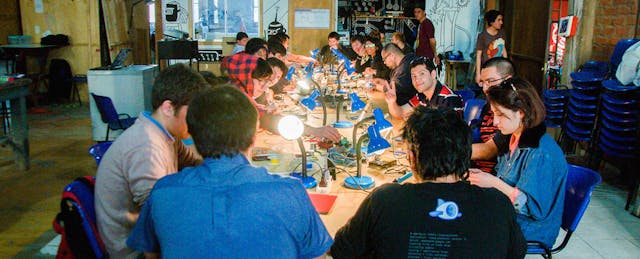Many schools, teachers, and administrators are embracing the concept of a maker space as they begin the 2015-16 school year. What is a maker space? It is a learning environment where children, teenagers, and teachers can create and tinker together using everyday materials. Here are six tips from Garden State educators who have recently set up maker spaces in their own schools.
1 Many hands make light work!
“Select activities that involve as many children as possible,” says Tiffany Lucey, Supervisor of Instructional Technology in Toms River, NJ. “They will learn teamwork and take ownership of their group accomplishment. For example, something as simple as building the tallest tower possible individually, and then combining resources, can bring the student experience soaring to great heights with an understanding of design within constraints."
2 Make it steamy!
Create a maker space that will infuse STEAM (Science, Technology, Engineering, Arts, and Mathematics) into the hearts and minds of a generation of 21st century learners. “STEAM is not a movement. It is the cornerstone of creativity and a staple of all educational systems to come," says Jay Eitner, Superintendent of Schools, Waterford Township, NJ. "STEAM is finally embracing all aspects of education that students need to be successful today--academics, the arts, and athletics."
3 Maker spaces work for all kinds of kids.
Maker spaces can work in both regular and special education settings. Trish Holzman is a SMILES teacher at the A. Harry Moore School of NJCU. SMILES is an acronym for Science and Math in Life Everyday, developed by principal Steve Goldberg. This year Holzman is developing a new maker space for her students with low incidence disabilities, such as blindness, orthopedic impairments, traumatic brain injury, etc.
City, suburban and rural school settings can all accommodate maker spaces. The urban Asbury Park school system has begun what one local newspaper called a “renaissance” under the leadership of Superintendent Dr. Lamont Repollet. Some of the newly hired administrators made it their mission to shake things up by creating maker spaces in both middle and elementary schools. “This self guided hands-on environment is only limited by the student's individual genius," says Asbury Park Middle School Principal Dr. RaShawn M. Adams. "All students need a place that can have real world application.”
4 Make the benefits clear to all teachers involved.
“Make sure everyone is on the same page,” says A. Henry Moore's Holzman. To ensure that the faculty understands the benefits of a maker space, she spoke to them about the maker concept on opening day. She also keeps open blocks of time on her schedule, allowing other teachers to bring their students into tinker.
5 Document your progress!
“Use tools like Instructables or a simple Google template or form to plan your project,” says Toms River’s Lucey. “Record the steps you took, progress along the way, and the outcomes. Most importantly, take time to reflect. Consider what went wrong and right and continue to revise the design. Push it to the limit!”
6 Release the locus of control!
“Allow your students to explore materials and how they interact. Allow room for play, mistakes, creativity and things that don’t work, and even things that break into what seems like a million pieces. These are the places where students discover their highest understanding,” adds Lucey. “Allow them to own it and they will never forget it.”
Many of these educators will be sharing their maker space passions and talents at the Jersey Shore Makerfest on October 17th in Toms River, New Jersey. A workshop/science fair/county fair all rolled into one, the event is supported by the New Jersey Department of Education Office of Educational Technology.


